Electric skateboards are battery-powered skateboards with electric motors that propel riders forward without pushing. In recent years, electric skateboards have grown tremendously in popularity, transitioning from a niche hobby to a mainstream transportation method.
Early versions of electric skateboards emerged in the 1990s but were limited by bulky lead-acid batteries with short runtimes. They were mostly viewed as novelty recreational devices. However, lithium battery and electric motor innovations in the 2000s enabled electric skateboards with extended range and higher speeds.

Today, sleek, high-performance electric skateboards can reach 20-25 mph and travel 15-30 miles on a single charge – enough for most commutes and errands around congested metro areas. With costs dropping below $500 in many cases, electric skateboards have hit a sweet spot of utility and affordability that has supercharged demand.
What Factors Have Contributed to the Rising Popularity of Electric Skateboards?
Several key factors have contributed to the rising popularity of electric skateboards:
- Improvements in lithium battery life and power, increasing range per charge to 15-30 miles in many cases. That enables use for commute and errands.
- More efficient, high torque hub motors that allow speeds of 20mph or more, rivaling urban bicycling.
- Declining costs as electric skateboard technology matures and production scales. Entry-level boards can now be purchased for under $300.
- A wider range of brands and models to choose from as the electric skateboard market expands. Everything from lightweight commuters to high-performance all-terrain boards.
- Desire for quick, convenient personal urban transportation for short 1-5 mile urban trips, without relying on cars or public transit.

The Electric Skateboard Market Today
The electric skateboard market has exploded in recent years. There are now dozens of brands catering to different needs and budgets. Prices typically range from about $300 for a basic short-range commuter board up to $2,000+ for a high-end, long-range model capable of 25+ mile rides.
College students have been a major driving force of demand, using electric skateboards to zip around large campuses between classes and dorms. Electric skateboard use has also surged in congested downtowns and urban neighborhoods, providing quick door-to-door transport for short trips under 3 miles.
Major metro areas like New York, Los Angeles, and San Francisco have been hotspots of electric skateboard adoption. However, their popularity has rippled out to smaller cities and suburbs as costs have declined.
Electric Skateboards Are Becoming More and More Popular and Widely Used for Transportation
Electric skateboards are now marketed for transportation, recreation, and sport, appealing to a wide demographic spanning teens to older working adults. Campus commuters and downtown dwellers seeking to avoid traffic and parking headaches have been early adopters. But usage has expanded as prices have dropped and new riders recognize the advantages.
Their integration into college campuses and urban transportation infrastructure reflects growing mainstream acceptance. Bike lanes provide legal and safe spaces to ride electric skateboards in many areas. Some cities have proposed licensing programs for electric skateboards used on roads. Electric skateboards provide a sustainable mobility option for commuters who avoid traffic and emissions while getting light exercise.
However, safety concerns remain a barrier to even broader adoption and legalization. Groups like the Electric Skateboard Safety Association advocate for responsible riding and reasonable regulations. Proper protective gear and avoiding reckless behavior are critical for both public perception and reducing injury risk. Ongoing improvements in stability technology and braking systems continue to make electric skateboarding safer as well.

The Future of Electric Skateboards
Experts expect rapid ongoing innovation and improvement in electric skateboard performance and safety. Lithium batteries will continue to shrink in size while increasing capacity. Motors will gain precision and power. Emerging suspension, braking, and stability control systems will aid handling and prevent falls at high speeds.
There is also a burgeoning accessory market with specialized tires, lights, racks, phone holders, and more for customizing boards. DIY enthusiasts build their high-power rigs as well. Regulations will likely adapt further to accommodate better electric skateboards in bike lanes and roads through licensing programs, speed limits, and other policies.
However, challenges remain for even broader mainstream adoption outside of major urban centers. Concerns about reckless riding on sidewalks and trails may persist. Lagging infrastructure, like bike lanes in some regions, also inhibit growth. But if embraced properly through education and reasonable policies, electric skateboards have enormous potential as sustainable urban transportation.
Conclusion
Electric skateboards have evolved from a niche novelty to a widely embraced transportation option in just a decade. Their surging popularity reflects the growing adoption of electric vehicles and micro-mobility solutions tailored for urban life. Ongoing improvements in technology, safety, and infrastructure integration will cement electric skateboards as a key component of the future commute. The electric skateboard movement illustrates how quickly innovations can shift from the fringe towards mainstream acceptance when their real-world utility and timing align with consumer demand.
Read More
- Master Emergency Braking On Electric Skateboard – Ecomobl
- Electric Skateboarding 101 Mastering The Ride – Ecomobl
- Exploring The Off Road Capabilities Of Electric Mountain Boards – Ecomobl
- Electric Mountain Board Safety Gear – Ecomobl
- Top 10 Off Road Electric Skateboards On The Market – Ecomobl




